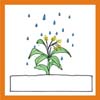From TKWB - Traditional Knowledge World Bank
Jump to navigation
Jump to search
| GENERAL DEFINITION OF THE TECHNIQUE |

|
| Technique: |
SOIL WATERING BY SPRINKLING WATER |
|
Definition characters description and diffusion
Sprinkler Irrigation is a method of applying irrigation water which is similar to rainfall. Water is distributed through a system of pipes usually by pumping. It is then sprayed into the air and irrigated entire soil surface through spray heads so that it breaks up into small water drops which fall to the ground
General characters description and diffusion
Sprinkler irrigation simulates rainfall in all respects, with the significant exception that both duration and intensity of fall can be controlled. Sprinkler irrigation has thus been quite successful in most countries applying the system, under the adverse conditions of poor-quality water, soils of restricted capability, and farmers new to farming. Compared to earlier methods , it represents a tremendous step forward. Sprinklers provide efficient coverage for small to large areas and are suitable for use on all types of properties. It is also adaptable to nearly all irrigable soils since sprinklers are available in a wide range of discharge capacity.
Sprinkler irrigation is adaptable to any farmable slope, whether uniform or undulating. The lateral pipes supplying water to the sprinklers should always be laid out along the land contour whenever possible. This will minimize the pressure changes at the sprinklers and provide a uniform irrigation.
Sprinklers are best suited to sandy soils with high infiltration rates although they are adaptable to most soils. The average application rate from the sprinklers (in mm/hour) is always chosen to be less than the basic infiltration rate of the soil so that surface ponding and runoff can be avoided.
Advantages and sustainability
By analyzing the statistics of agricultural production, it is obvious that using the sprinkler irrigation technique will save 40-60 percent of water. This irrigation system is widely adopted in the crop field in most plain areas. The cost of installing a sprinkler system is high, but the benefit arising from saving water is also remarkable, particularly in areas with limited water resources.
Images
Deepening
|
TRADITIONAL TECHNIQUE DATA
| Technique |
| SOIL WATERING BY SPRINKLING WATER |
| Icon |
 |
| Cathegory |
| B - Agriculture |
| Identification code |
| B10a |
| Author: |
|
| Other authors: |
|
| Reference: |
http://www.fao.org/docrep/s8684e/s8684e06.htm
|
|
|